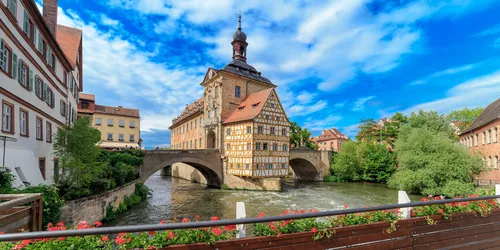On the road with DB Regio Bayern
The most beautiful UNESCO heritage sites in Bavaria
From Bamberg to Weißenburg: We present you the most impressive cultural heritage sites and historical excursion destinations in Bavaria.

48 sites have been declared UNESCO World Heritage Sites in Germany, and many of them are located in Bavaria. UNESCO, by the way, is short for the United Nations Educational, Scientific and Cultural Organization. We'll take you to the five most spectacular sites! Explore Bayreuth's baroque opera house, Bamberg's historic old town, Bad Wörishofen's cultural Kneipp facilities, Würzburg's imposing residence and the impressive Roman Limes in Weißenburg.
Bayreuth Margravial Opera House
Bayreuth is best known for its opera festival, which even our former chancellor Angela Merkel regularly attended. However, it is not only the operas that are impressive, but also the venues. The Margravial Opera House is the world's best preserved example of a free-standing Baroque court theater. That is why it was included in the list of World Heritage Sites by UNESCO in 2012. Margravine Wilhelmine of Brandenburg-Bayreuth had the pompous structure built in 1748 for the wedding of her daughter Elisabeth Friederike Sophie. Take the opportunity to see the Margravial Opera House in Bayreuth from the inside, the magnificent interior and the spatial experience are overwhelming.
Bamberg's historic old town
The 77,000-inhabitants:inside city of Bamberg - to be precise its beautiful old town - has been one of the UNESCO cultural heritage destinations in Bavaria since 1993. Since then, the beautiful city has been a World Heritage Site. Bamberg is also called "the Bavarian Rome", because the old town was built on seven hills, just like ancient Rome. The World Heritage Site stretches over three very different, centuries-old parts of the city: Be sure to visit the imperial cathedral on the Domberg in the Bergstadt, the old town hall built on an artificial island directly in the Regnitz River in the Inselstadt, and the inner-city gardens of the Gärtnerstadt.
Bad Wörishofen's cultural Kneipp facilities
What the priest and naturopath Sebastian Kneipp established as cold water therapy over 150 years ago can still be experienced today in the spa town of Bad Wörishofen. UNESCO proclaimed the world-famous "Kneippen," or treading in cold water, an intangible cultural heritage at its place of origin, Bad Wörishofen, in 2015. At 23 Kneipp facilities throughout the town, you can experience Kneipp's holistic teaching of natural healing and find more harmony for body, mind and soul with the help of the five elements of water, herbs, nutrition, lifestyle and exercise.
Würzburg's imposing Residence
In the middle of the old town lies the Würzburg Residence, which UNESCO declared a World Heritage Site in 1981. The 300-year-old Baroque palace, which was commissioned by two prince-bishops as patrons at the beginning of the 18th century, is one of the most important palace complexes in Europe and historical excursion destinations in Bavaria. Visitors:inside can admire original furnishings in 40 different period rooms, for example furniture and art treasures from the first half of the 18th century. The eye-catcher - in the truest sense of the word - is the mirrored Kaisersaal with its magnificent stucco ceiling, which UNESCO even calls "the most perfect spatial work of art of the rococo period." Be sure to also take a look around the Hofgarten and Residenzplatz. They complete this outstanding work of art of the European Baroque.